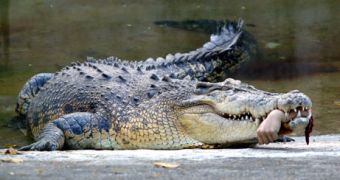Allegations about lousy conditions on the state-run Shoushan Zoo in Kaohsiung, the second largest city of Taiwan, where a crocodile bit off the forearm of a veterinarian last month seem to explain the attack.
The gruesome incident, which took place on April 11, was captured in photos wide spread by international media. After a few days, it appeared that the Nile crocodile was in fact a saltwater crocodile, a more aggressive species.
Recently, one of the zoo's main attractions, an African elephant thought to be male, actually resulted to be female. "We authorize[d] the institute of wildlife conservation to re-check and identify the gender and species of all animals in the zoo so that the public would not be misinformed again," said Jason Fu-Feng Hung, director of the Kaohsiung government entity to National Geographic News.
But many recent events reveal serious problems at this zoo. "Among the three government-run zoos on Taiwan, Shoushan is the worst one," said Wu Hung, director of the Environment and Animal Society of Taiwan (EAST), an animal-welfare organization.
Eyewitness accounts, photos, and videos reveal a zoo with lax regulations, disastrous facilities and an untrained staff.
In August 2003, a baby hippo was spotted at the bottom of a pool. "We told zoo workers there was a baby hippopotamus dying in the bottom of the pool. They took water out and found it. They told us they didn't even know the mother had been pregnant."
Animals are exposed in grassless, undersized concrete cages and appear to suffer of captivity stress. Hung related that in 1999, feral dogs killed four red-necked wallaby inside the zoo. "The zoo is outdated and, ideally, should be closed. Nearly every exhibit is antiquated in design-predominantly old-style grottos, pits, and small, fenced ungulate [hoofed animal] yards. Cages are grossly undersized and barren with inappropriate concrete or compacted-earth floor surfaces, solid walls or barriers that allow no opportunity for animals to view the outside world. Exhibits contained no "features, furnishings, or objects to facilitate natural movements or behaviors", said biologist Rob Laidlaw, director of the Canadian group Zoocheck which monitors captive animals since 1984, who visited Shoushan in November 2004.
Other experts also added that there is little control over feeding by visitors. "The condition of the zoo right now is nothing like the impression that you might have from viewing those photos," said Fu-Feng Hung
EAST's experts disagree. "The zoo is in the exact condition as the pictures show. However, the turning point may come soon, as the Kaohsiung city government is now organizing a task force which aims to assess the zoo and the possibility of its transformation," said Hung.
Fu-Feng Hung says that critics overlook the recent improvements. "In 2006 the zoo put grass in the lion grotto and added a pool and some branches to the brown bear exhibit. Our main concern right now is to try as hard as we can to protect animal welfare."

 14 DAY TRIAL //
14 DAY TRIAL //